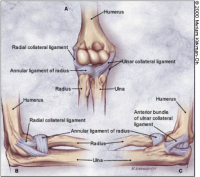Elbow Valgus Stress: Difference between revisions
Tyler Shultz (talk | contribs) No edit summary |
(updated the evidence section) |
||
| (28 intermediate revisions by 12 users not shown) | |||
| Line 1: | Line 1: | ||
= | <div class="editorbox"> | ||
'''Original Editor '''- [[User:Tyler Shultz|Tyler Shultz]] | |||
{ | '''Original Editors''' - {{Special:Contributors/{{FULLPAGENAME}}}}</div> | ||
== Purpose == | |||
The elbow valgus stress test is used to assess the integrity of the medial collateral ligament, also known as the ulnar collateral ligament.<br> | |||
[[Image:Elbow_Ligaments.png|thumb|right|200px|Elbow Ligaments]] | |||
== Technique | == Technique == | ||
This test can be performed with the patient supine, sitting, or in the standing position. The therapist places the patients elbow in approximately 20 degrees of flexion while palpating the medial joint line and stabilizing the distal humerus with one hand and applying a valgus stress to the elbow with the other hand.<ref>Flynn, T.W., Cleland, J.A., Whitman, J.M. (2008). User's guide to the musculoskeletal examination: Fundamentals for the evidence-based clinician. Buckner, Kentucky: Evidence in Motion</ref><ref>Dutton, M. (2008). Orthopaedic: Examination, evaluation, and intervention (2nd ed.). New York: The McGraw-Hill Companies, Inc.</ref> The test is considered positive if the patient experiences pain or excessive laxity is noted compared to the contralateral side.<ref>Flynn, T.W., Cleland, J.A., Whitman, J.M. (2008). User's guide to the musculoskeletal examination: Fundamentals for the evidence-based clinician. Buckner, Kentucky: Evidence in Motion</ref> As with the [[ | This test can be performed with the patient supine, sitting, or in the standing position. The therapist places the patients elbow in approximately 20 degrees of flexion while palpating the medial joint line and stabilizing the distal humerus with one hand and applying a valgus stress to the elbow with the other hand.<ref>Flynn, T.W., Cleland, J.A., Whitman, J.M. (2008). User's guide to the musculoskeletal examination: Fundamentals for the evidence-based clinician. Buckner, Kentucky: Evidence in Motion</ref><ref>Dutton, M. (2008). Orthopaedic: Examination, evaluation, and intervention (2nd ed.). New York: The McGraw-Hill Companies, Inc.</ref> The test is considered positive if the patient experiences pain or excessive laxity is noted compared to the contralateral side.<ref>Flynn, T.W., Cleland, J.A., Whitman, J.M. (2008). User's guide to the musculoskeletal examination: Fundamentals for the evidence-based clinician. Buckner, Kentucky: Evidence in Motion</ref> As with the [[Elbow Varus Stress|varus stress test]], this test can be repeated in varying degrees of elbow extension to test different portions of the MCL.<ref>Dutton, M. (2008). Orthopaedic: Examination, evaluation, and intervention (2nd ed.). New York: The McGraw-Hill Companies, Inc.</ref><br><br> | ||
= | {{#ev:youtube|Cd25qGCo-kQ|300}}<ref>CR Technologies. Valgus Stress Test - Elbow (CR). Available from: http://www.youtube.com/watch?v=Cd25qGCo-kQ [last accessed 26/03/14]</ref> | ||
== Evidence == | |||
There is little evidence available to support the elbow valgus stress test. Alternatively, the [[Moving Valgus Stress Test]] appears to be better supported by the current body of evidence. | |||
== References | == References == | ||
<references /> | <references /> | ||
[[Category:Special_Tests]] | |||
[[Category:Elbow]] | |||
[[Category:Assessment]] | |||
[[Category:Elbow - Assessment and Examination]] | |||
[[Category:Ligaments]] | |||
[[Category:Musculoskeletal/Orthopaedics]] | |||
[[Category:Primary Contact]] | |||
[[Category:Sports Medicine]] | |||
[[Category:Athlete Assessment]] | |||
[[Category:Elbow - Special Tests]] | |||
Latest revision as of 14:32, 26 April 2024
Original Editor - Tyler Shultz
Original Editors - Rachael Lowe, Admin, Tyler Shultz, Kim Jackson, Laura Ritchie, Evan Thomas, Saud Alghamdi, Tony Lowe, Kai A. Sigel, WikiSysop, Claire Knott and Wanda van NiekerkPurpose[edit | edit source]
The elbow valgus stress test is used to assess the integrity of the medial collateral ligament, also known as the ulnar collateral ligament.
Technique[edit | edit source]
This test can be performed with the patient supine, sitting, or in the standing position. The therapist places the patients elbow in approximately 20 degrees of flexion while palpating the medial joint line and stabilizing the distal humerus with one hand and applying a valgus stress to the elbow with the other hand.[1][2] The test is considered positive if the patient experiences pain or excessive laxity is noted compared to the contralateral side.[3] As with the varus stress test, this test can be repeated in varying degrees of elbow extension to test different portions of the MCL.[4]
Evidence[edit | edit source]
There is little evidence available to support the elbow valgus stress test. Alternatively, the Moving Valgus Stress Test appears to be better supported by the current body of evidence.
References[edit | edit source]
- ↑ Flynn, T.W., Cleland, J.A., Whitman, J.M. (2008). User's guide to the musculoskeletal examination: Fundamentals for the evidence-based clinician. Buckner, Kentucky: Evidence in Motion
- ↑ Dutton, M. (2008). Orthopaedic: Examination, evaluation, and intervention (2nd ed.). New York: The McGraw-Hill Companies, Inc.
- ↑ Flynn, T.W., Cleland, J.A., Whitman, J.M. (2008). User's guide to the musculoskeletal examination: Fundamentals for the evidence-based clinician. Buckner, Kentucky: Evidence in Motion
- ↑ Dutton, M. (2008). Orthopaedic: Examination, evaluation, and intervention (2nd ed.). New York: The McGraw-Hill Companies, Inc.
- ↑ CR Technologies. Valgus Stress Test - Elbow (CR). Available from: http://www.youtube.com/watch?v=Cd25qGCo-kQ [last accessed 26/03/14]







